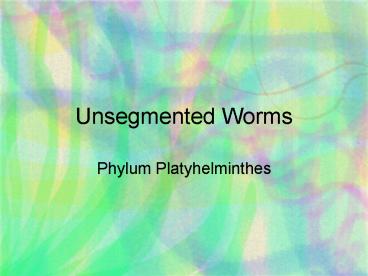Unsegmented Worms - PowerPoint PPT Presentation
1 / 38
Title:
Unsegmented Worms
Description:
True coelom. w/ mesentary (holds gut in place) & peritoneum (mesodermal. lining of body cavity. The Coelom or Body Cavity Advances. D. Phylum Platyhelminthes ... – PowerPoint PPT presentation
Number of Views:168
Avg rating:3.0/5.0
Title: Unsegmented Worms
1
Unsegmented Worms
- Phylum Platyhelminthes
2
Advantage of Being Flat
- Surface area to volume ratio is important for
organisms. - many substances enter and leave through body
surface. - Faster absorption and release of wastes
3
I. Unsegmented worms
- A. Worms that are not
- divided into sections
- externally internally
- B. Eg.
- 1. Phylum Platyhelminthes
- aka flatworms
- 2. Phylum Nematoda
- aka Roundworms
4
Phylum Platyhelminthes the Flatworms
5
C. What is a coelom?
- fluid-filled
- body cavity
- between
- body wall
- digestive tract
6
Kinds of coelom
- Acoelomate no coelom
- i.e. body cavity is
- NOT fluid filled
7
Kinds of coelom
2. Pseudocoelomate Fluid filled body
cavity BUT No mesentary or
peritoneum
8
Kinds of coelom
3. Eucoelomate True coelom w/ mesentary
(holds gut in place) peritoneum
(mesodermal lining of body cavity
9
The Coelom or Body Cavity Advances
10
D. Phylum Platyhelminthes
- 1. Class Turbellaria planarians
- 2. Class Trematoda flukes
- 3. Class Cestoda tapeworms
11
D. Phylum Platyhelminthes
- Also Acoelomate
- Phylum Nemertea ribbon worms
- Phylum Gnathostomulida-
- jaw worms
12
E. General Info re Flatworms
- 1. platy flat
- helminth worm
- 2. Body structure
- a. Size range 1 mm ------?
- many meters (Cestoda)
- b. Shape flattened dorso-ventrally
- c. Only several cell layers thick
13
E. General Info re Flatworms
? Cells fill body cavity (not fluid)
14
F. Level of Organization
- organ system
15
G. Symmetry
- bilateral
- (has forward movement cephalization)
I m a little bilateral animal too!
16
H. Habitat
- aquatic (freshwater
- or marine)
- moist soil
- endoparasites of vertebrates
17
I. Feeding - Class Turbellaria
- Planarians-
- mostly
- free-living
- carnivore
- or
- scavengers
18
I. Feeding - Class Turbellaria
- Incomplete digestive tract one opening (no
anus) - Mouth on ventral side
- Protrusible pharynx
- Gastrovascular cavity (GVC)
- Intestine very branched
- Enzymes digest food
19
I. Feeding - Class Trematoda
- Parasitic flukes
- endoparasites
- of
- vertebrates
- need only
- minimal
- digestive tract
- E.g. Human Liver fluke
20
I. Feeding Class Cestoda
- tapeworms
- Endo-parasites
- Scolex w/ hooks suckers
- NO need for dig. tract
- absorbs nutrients from gut of host
scolex
suckers
21
J. Respiration
- - via diffusion
- (only a few cell layers thick)
22
K. Internal transport
- via diffusion
Marine flatworm
23
L. Excretion via diffusion
- EXCEPTION planarians have
- flame cells ( w/ flagella
- that help move waste to
- excretory pores, then out of the body
24
M. Response (Nervous system)
- Primitive brain anterior ganglia
- ganglion cluster of nerve
cells - 2. Two Longitudinal nerves (the length of the
body) - 3. Ladder-like cross-bridges of nerves
25
M. Response (Nervous system)
26
M. Response (Nervous system)
- 4. Sense organs (flatworms)
- a. Ocelli eyespots / photodetectors
- b. Auricles -
- contain chemoreceptors (chemicals)
- thigmoreceptors (touch)
- c. Statocysts balance
- d. Rheoreceptors sense
- direction of water current
27
Nervous System and Sense Organs
- Have a Nerve-net.
- Most have more complex system.
- Cerebral ganglion primitive brain coordinates
impulses. - Ladder system carries impulses throughout body
- Many sense organs present
- Eyespots
- Chemoreceptors, touch sensors and rheoreceptors
(sense direction) also common
28
(No Transcript)
29
(No Transcript)
30
N. Locomotion
- - Planaria
- use cilia,
- slime,
- circular and
- longitudinal muscles
- to GLIDE
- Trematoda, Cestoda little motion
cilia
31
O. Reproduction
- 1. Asexual Regeneration (Planaria only)
- 2. Sexual
- a. pattern monoecious (hermaphrodites)
- b. cross- fertilization (swap sperm)
32
Reproduction in Free-living Flatwormssuch as
Planarians
- May reproduce sexually or asexually
- Asexual
- Binary fission split in two
- Sexual
- Both sexes present in same flatworm
(hermaphrodites). - Fertilization internal, eggs produced
- Embryos emerge as juveniles resembling adults.
33
Reproduction in theTapeworm!
- Lack digestive system
- Sucker and hooks on anterior end for attachment
- Neck produces new segments
- Called proglottids
- Each proglottid contains male and female gonads
- Reproductive output high
- Many proglottids per worm
- Many eggs per proglottid
34
(No Transcript)
35
(No Transcript)
36
Tapeworm - Life Cycle
37
Flukes -- Life Cycle of a Liver Fluke
38
P. Ecological Roles
- 1. Scavengers/ predators recycle nutrients to
ecosystem (Class Turbellaria) - 2. Prey for fish birds (Class Turbellaria)
- 3. Endo-parasites (cause disease)
- (Class Trematoda Class Cestoda)































